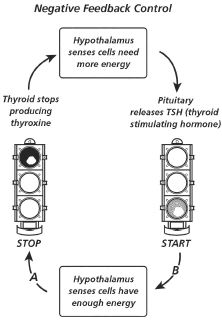Multiple Choice
Identify the choice that best completes the
statement or answers the question.
|
|
|
1.
|
Why do hormones cause changes only in specific body organs?
a. | A hormone works only through negative feedback. | b. | A hormone is
produced only in the location where it is needed. | c. | A hormone interacts only with target cells,
which fit together with that hormone. |
|
|
|
2.
|
The endocrine system acts on the body through chemical products called
a. | target cells. | b. | blood and saliva. | c. | hormones. |
|
|
|
3.
|
The endocrine system produces chemicals that
a. | control both daily activities and long-term changes through
hormones. | b. | require a system of nerves to control many body activities. | c. | begin to function
after puberty. |
|
|
|
4.
|
Which endocrine gland(s) link(s) the endocrine system and the nervous
system?
a. | hypothalamus | b. | pituitary gland | c. | thyroid
gland |
|
|
|
5.
|
Which endocrine gland(s) communicate(s) with the hypothalamus to control many
body activities, including growth from infancy to adulthood?
a. | thyroid gland | b. | pituitary gland | c. | adrenal
glands |
|
|
|
6.
|
The way the endocrine system maintains homeostasis is often compared to
a(n)
a. | violent thunderstorm that startles people and increases their
heartbeat. | b. | heating system that turns a furnace on and off to control a room’s
temperature. | c. | monthly cycle that releases an egg from an ovary. |
|
|
|
7.
|
Which of the following is an example of negative feedback in the endocrine
system?
a. | When the amount of a hormone reaches a certain level, the endocrine system stops the
release of that hormone. | b. | When a hormone travels through the bloodstream,
it will interact only with its target cells. | c. | When people are startled by a frightening
event, their heart beats faster. |
|
|
|
8.
|
The endocrine system often uses a negative feedback process to
a. | bring about fertilization. | b. | maintain homeostasis. | c. | control the
production of eggs and sperm. |
|
|
|
9.
|
Which of the following structures is formed when fertilization occurs?
|
|
|
10.
|
The joining of a sperm and an egg is called
a. | ovulation. | b. | fertilization. | c. | menstruation. |
|
|
|
11.
|
Sperm are produced in the
a. | testes. | b. | bladder. | c. | scrotum. |
|
|
|
12.
|
The scrotum is part of the
a. | male reproductive system. | b. | menstrual cycle. | c. | endocrine
system. |
|
|
|
13.
|
Eggs are produced in the
a. | fallopian tubes. | b. | uterus. | c. | ovaries. |
|
|
|
14.
|
Human eggs are usually fertilized in the
a. | fallopian tube. | b. | uterus. | c. | ovary. |
|
|
|
15.
|
A mature egg is released from the ovary during a process called
a. | fertilization. | b. | menstruation. | c. | ovulation. |
|
|
|
16.
|
In a female’s body, an egg develops in an ovary, and the uterus prepares
for the arrival of a fertilized egg during
a. | labor and delivery. | b. | pregnancy. | c. | the menstrual
cycle. |
|
|
|
17.
|
When a human egg is not fertilized, extra blood and tissue from the uterus are
released through the vagina in a process called
a. | elimination. | b. | menstruation. | c. | ovulation. |
|
|
|
18.
|
Where does a fertilized egg develop after it leaves the fallopian tube?
a. | the uterus | b. | the ovary | c. | the
cervix |
|
Essay
|
|
|
19.
|
Explain how the following NEGATIVE FEEDBACK system works. 
|